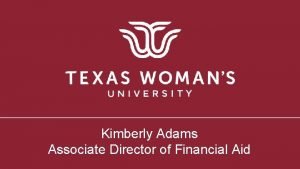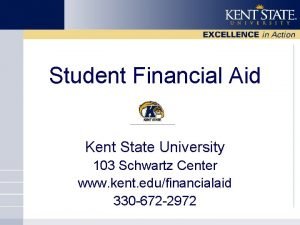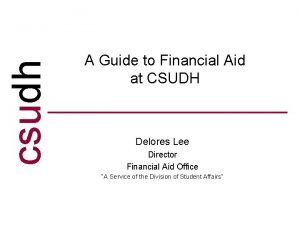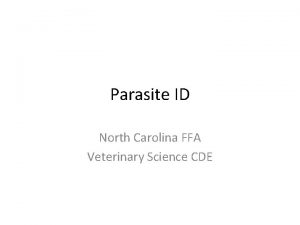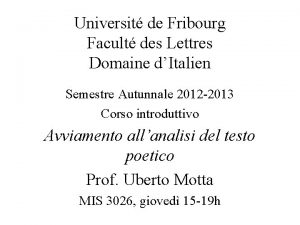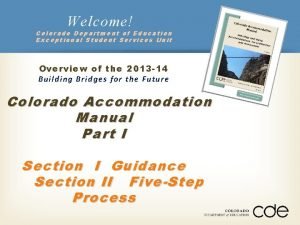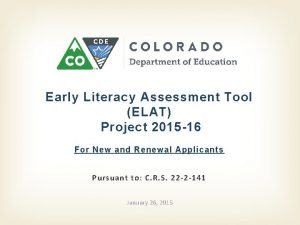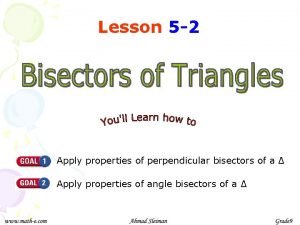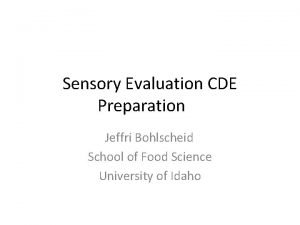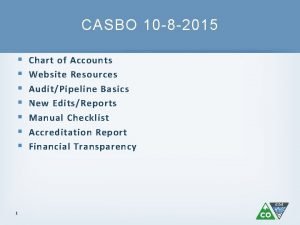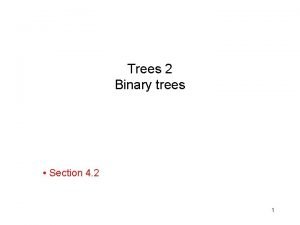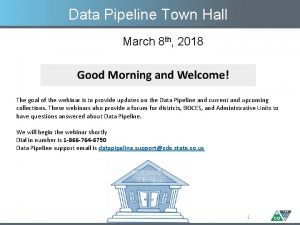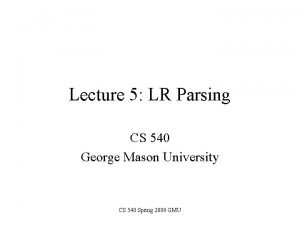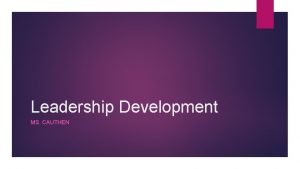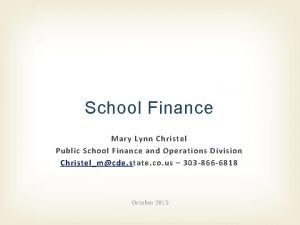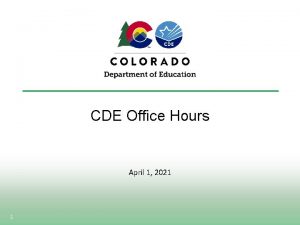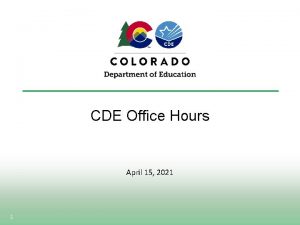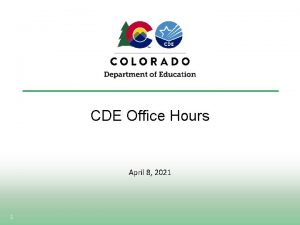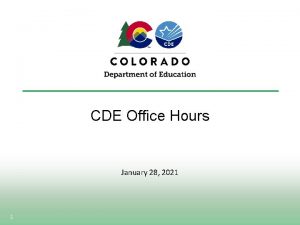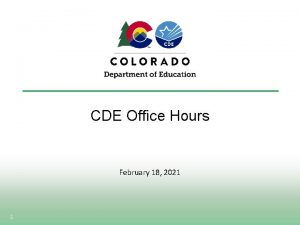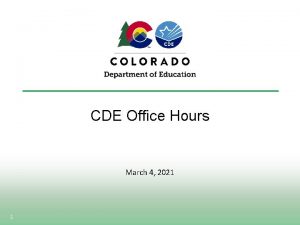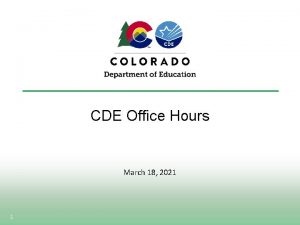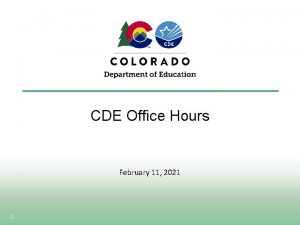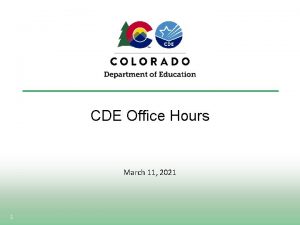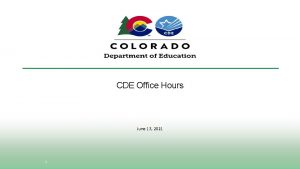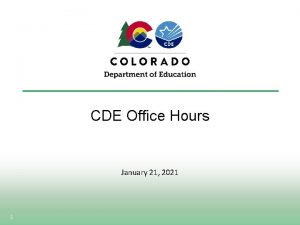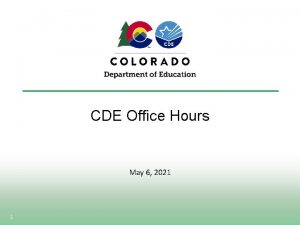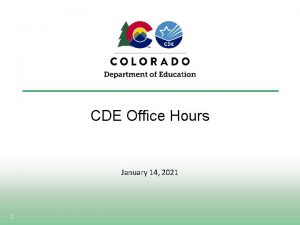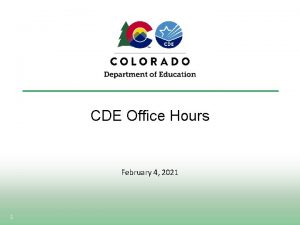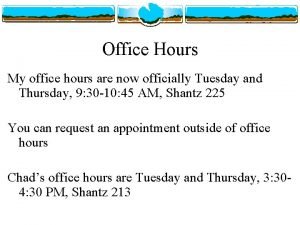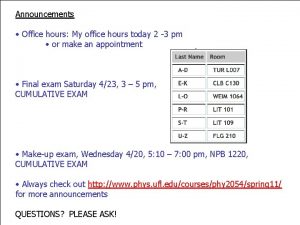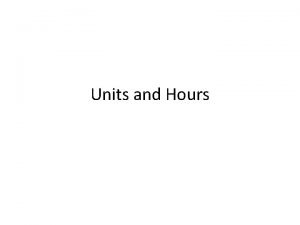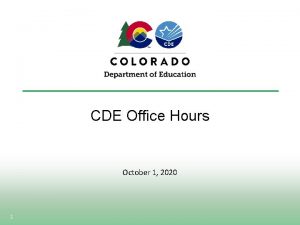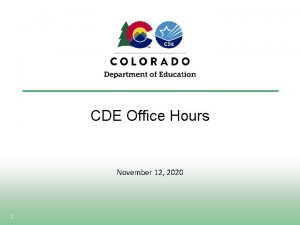CDE Office Hours April 29 2021 1 CDE




















- Slides: 20

CDE Office Hours April 29, 2021 1

CDE Team Introductions! ESSER/ESEA • Nazie Mohajeri-Nelson, Director of ESEA Office (mohajeri-nelson_n@cde. state. co. us) • De. Lilah Collins, Assistant Director of ESEA Office (collins_d@cde. state. co. us) • Mary Ann Caterina, ESSER Monitoring & Reporting Specialist (caterina_m@cde. state. co. us) • Kristin Crumley, ESSER Monitoring & Reporting Specialist (Crumley_k@cde. state. co. us) • ESEA Regional Contacts assigned to your district Fiscal Experts • Jennifer Okes, Chief Operating Officer (okes_j@cde. state. co. us) • Kate Bartlett, Executive Director of School District Operations (Bartlett_k@cde. state. co. us) • Jennifer Austin, Director of Grants Fiscal Management (Austin_j@cde. state. co. us) • Robert Hawkins, Grants Fiscal Analyst (Hawkins_s@cde. state. co. us) • Steven Kaleda, Grants Fiscal Analyst (Kaleda_s@cde. state. co. us) • Adam Williams, Financial Data Coordinator (Williams_a@cde. state. co. us) 2

ESSER Office Hours Topics • ESEA Updates • Accountability Waiver – Approved on April 21, 2021 • ESSER Updates and Clarifications • • • Hydrogen Peroxide or Bi-Polar Ionization Systems (Andy Stine) ESSER Updates ESSER Reporting and Planning Requirements • • • ESSER I Reporting Requirements ESSER III Planning and Reporting Requirements Mc. Kinney-Vento Funds • Questions 3 Recent Information from USDE: ARP Application for the 1/3 of the award – 4/21/21 Interim Final Rule – 4/21/21 Weekly Office Hours – 4/29/21

ESEA Updates 4

ESSA Accountability Waiver • Federal Accountability Waiver: CDE released a draft and collected feedback until March 31; based on stakeholder input, CDE submitted accountability waiver on 4/6/21 to USDE – Approved on 4/21/21. • ESSA Identification • • • 5 Will be able to exit schools identified due to graduation rates only Will not be able to identify new schools until fall of 2022 Limitations/implications for EASI funding • Same list, minus those that meet exit criteria • Open on the same timeline • Looking for input on • Prioritization • Revamping supports to meet current needs

ESSER Updates, Clarifications, and Follow-Ups 6

Hydrogen Peroxide and Bipolar Ionization Systems • Not contemplated in Building Excellent Schools Today’s Construction Guidelines • Note required to comply with current code or COVID-19 reopening guidance • CDPHE and the EPA have expressed concerns with hydrogen peroxide systems • CDPHE/CDE guidance related to HVAC can be found here: http: //www. cde. state. co. us/planning 20 -21/reopeningschools-faq • CDPHE recommends focusing on optimizing current HVAC systems, increased air exchanges, and improved filtration, social distancing, wearing masks, and cleaning hands and surfaces. 7

Clarification on Construction • An allowable use of ESSER funds but… • • • Will need prior written approval from CDE. • • 8 Awaiting U S Contradictory requirements between UGG and statute Budgeted items must be reasonable, necessary, and allocable. Must comply with applicable requirements in 34 CFR section 76. 600 and 34 CFR sections 75. 600– 617, all other applicable Uniform Guidance requirements, as well as the ED’s regulations regarding construction, as applicable, at 34 CFR section 76. 600. • • dating k nce onbac DE Guida UGG Example: 2 CFR 200. 318(h) • The non-Federal entity must award contracts only to responsible contractors possessing the ability to perform successfully under the terms and conditions of a proposed procurement. Consideration will be given to such matters as contractor integrity, compliance with public policy, record of past performance, and financial and technical resources. See also § 200. 214. As is the case with all construction contracts using laborers and mechanics financed by federal education funds, recipients and subrecipients that use ESSER or GEER funds for construction contracts over $2, 000 must meet Davis-Bacon prevailing wage requirements. For information about the prevailing wages in the applicable region. Subject to applicable inventory control, log maintenance, and disposition requirements consistent with Part 3, Section F, “Equipment/Real Property Management” of the August 2020 Compliance Supplement. Must comply with local and state procurement policies. Occur during the period of availability of funds.

Construction Approval • Application for funds does not require you to include how activities comply with federal regulations • However, documentation is required for monitoring purposes • Recommendation: use a contractor/vendor who has experience with working under federal regulations • As of right now, we cannot approve backdating for construction (except for those that have CDE approval under BEST grant applications) • For upcoming capital expenses (buses and construction) • 9 if not ready to submit your full budget application, can request a prior written approval by providing all of the details from the application for that budget line item(s) • Must include dates of construction/bus purchase • Will not be able to draw down funds until final approval

Timelines Associated with ESSER I, II, and III ESSER I (CARES Act) ESSER II (CRSSA Act) ARP ESSER III (ARP Act) 03/13/20 – 09/30/21 03/13/20 – 09/30/22 03/13/20 – 09/30/23 Tydings Period - will end and funds must be spent by 9/30/22 9/30/23 9/30/24 USDE Award to CDE 05/07/20 01/06/21 3/24/21 05/07/21 Final Approval 01/06/22 Final Approval 05/23/21 Substantial Approval Application must have final approval 05/07/21 01/06/22 03/24/22 CDE Must Make Subgrants via Contract or Grants (10%) 05/07/21 01/06/22 03/24/22 CDE Application Opened 05/31/20 02/12/21 4/27/21 NA NA 5/23/21 12/31/20 09/30/21 03/24/22 Date of Final Approval PAR Closes 06/30/21 06/30/22 06/30/23 Carryover Application Will Open (Unexpended Funds Carried Over to Next Year) 07/01/21 07/01/22 06/30/23 Carryover Application Will Close 06/30/22 06/30/23 06/30/24 First Day of Each Month 09/30/22 09/30/23 9/30/24 October/November 2022 October/November 2023 October/November 2024 Award Period CDE Must Make Subgrants to LEAs (90%) – LEAs must have final approval on ESSER I and II and substantial approval on ESSER III Preliminary Application (T&A, assurances, GEPA) due CDE Application Closed/Closes PAR Open – Rolling Basis Monthly Deadline for Requesting Funds (LEA’s Request for Funds, RFF) Deadline for Final Spending (obligation) Deadline for Final Draw Down of Funds (RFF)

Application Updates and Reminders • CARES ESSER I – State Reserve • Facility School must submit applications by May 7, 2021 • CRSSA ESSER II – State Reserve • • Supplemental Funds are now in the system AU’s have a separate application within the same system • ARP ESSER III – 90% • • Application is now live! Must submit by May 23, 2021 • • Must submit by March 24, 2022 • 11 GEPA Statement Assurances Transmittal and Acceptance Form Balanced budget Currently experiencing technical issues with sending comments back to the district in the ESSER II and III apps

ESSER III Application • GEPA Statement: • Allowed to refer to the Cons App but must make sure that the GEPA statement in the Cons App addresses the action steps that will ensure equitable access to, and participation in, the ESSER funded programs for students, teachers, and other program beneficiaries. • If the Cons App statement is too limited, you have the option to write an ESSER-specific one or to submit revisions to the GEPA statement in the ESSER up to explain how it differs for ESSER in the ESSER app. • Feedback you will receive once you submit the preliminary application: 12 • Thank you for your ESSER III Application submission. Your application has been granted Substantial Approval and you can begin to obligate funding to program activities. A comprehensive review of the application will begin once a completed budget has been submitted. Keep in mind that you will not be able to request reimbursement of expenses incurred until final approval has been granted. Please revisit the application and make funding decisions by March 24, 2022. • Next steps after you submit preliminary app • If budget included/if not budget included

ESSER Reporting and Plan Requirements 13

ESSER I Reporting Requirements • We were able to submit the data on behalf of districts for almost all data elements requested from the information in our application for funds! • Except for one… • 14 If the LEA used ESSER funds to develop, initiate and/or implement remote learning, please mark all methods used to document student participation and engagement during remote learning (separately for elementary and secondary): • Submission of assignments • Participation in assessments • Tracking student logins to online learning platforms • Participation in individual coaching or check ins • Participation in email, text or other electronic communication • Participation in help lines or hot lines for help with remote learning. • Participation in synchronous online classes • Other

Publicly Posted Safe Return to In-Person Instruction and Continuity of Services Plan Criteria from the Interim Final Rule • The extent to which the LEA has adopted policies and a description of any such policies on each of the following health and safety strategies: • • universal and correct wearing of masks; physical distancing (e. g. , use of cohorts/podding; handwashing and respiratory etiquette; cleaning and maintaining healthy facilities, including improving ventilation; contact tracing in combination with isolation and quarantine, in collaboration with the State, local, territorial, or Tribal health departments; diagnostic and screening testing; efforts to provide vaccinations to educators, other staff, and students, if eligible; and appropriate accommodations for children with disabilities with respect to health and safety policies, and how the LEA will ensure continuity of services including but not limited to services to address the students’ academic needs, and students’ and staff social, emotional, mental health, and other needs, which may include student health and food services. If an LEA developed a plan before ARP was enacted that does not address the above requirements, the LEA must revise its plan no later than six months after it last reviewed its plan. 15

LEA Safe Return Plans (Cont. ) • IFR also requires that the plans must • • 16 be in an understandable and uniformat; to the extent practicable, written in a language that parents can understand or, if not practicable, orally translated; and upon request by a parent who is an individual with a disability, provided in an alternative format accessible to that parent. Please note that LEAs need to update the Safe Return to In-Person Instruction and Continuity of Services Plan at least every six months through September 30, 2023, and must seek public input on the plan and any revisions, and must take such input into account.

LEA ARP ESSER Plans More from the IFR! • LEAs must submit LEA ARP ESSER Plans within a reasonable timeline established by the CDE (USDE recommends within 90 days of receipt of funds). • Plans must be developed in consultation with stakeholders and at a minimum describe: • • 17 The extent to which and how ARP ESSER funds will be used by the LEA to implement prevention and mitigation strategies that are, to the greatest extent practicable, in line with the most recent CDC guidance, How the LEA will use the mandatory 20% set-aside for to address the academic impact of learning loss or “lost instructional time” through the implementation of evidence-based interventions, How the LEA will use the remaining ARP ESSER funds consistent with statutory requirements, and How the LEA will ensure that the ARP ESSER funded interventions, including but not limited to the 20% set-aside, will respond to the academic, social, emotional, and mental health needs of all students, and particularly those students disproportionately impacted by the COVID-19 pandemic, including students from low-income families, students of color, English learners, children with disabilities, students experiencing homelessness, children and youth in foster care, and migratory students.

ARP ESSER III • There are several reporting requirements on ESSER III’s Grant Award Notification to CDE that require LEA level data • • • 18 Data on each school’s mode of instruction (fully in-person, hybrid, and fully remote) and conditions [must be posted on CDE’s website by June 21, 2021, plus student enrollment data for each mode by all students and disaggregated by student groups, and if available attendance data] SEA and LEA uses of funds to meet students’ social, emotional, and academic needs, including through summer enrichment programming and other evidencebased interventions, and how they advance equity for underserved students SEA and LEA uses of funds to sustain and support access to early childhood education programs Impacts and outcomes (disaggregated by student subgroup) through use of ARP ESSER funding (e. g. , quantitative and qualitative results of ARP ESSER funding, including on personnel, student learning, and budgeting at the school and district level) Student data (disaggregated by student subgroup) related to how the COVID-19 pandemic has affected instruction and learning

Questions? Future Topics? 19

CDE Team Contact Information ESSER/ESEA • Nazie Mohajeri-Nelson, Director of ESEA Office (mohajeri-nelson_n@cde. state. co. us) • De. Lilah Collins, Assistant Director of ESEA Office (collins_d@cde. state. co. us) • Mary Ann Caterina, ESSER Monitoring & Reporting Specialist (caterina_m@cde. state. co. us) • Kristin Crumley, ESSER Monitoring & Reporting Specialist (Crumley_k@cde. state. co. us) • ESEA Regional Contacts assigned to your district Fiscal Experts • Jennifer Okes, Chief Operating Officer (okes_j@cde. state. co. us) • Kate Bartlett, Executive Director of School District Operations (Bartlett_k@cde. state. co. us) • Jennifer Austin, Director of Grants Fiscal Management (Austin_j@cde. state. co. us) • Robert Hawkins, Grants Fiscal Analyst (Hawkins_s@cde. state. co. us) • Steven Kaleda, Grants Fiscal Analyst (Kaleda_s@cde. state. co. us) • Adam Williams, Financial Data Coordinator (Williams_a@cde. state. co. us) 20
 Twu bursar
Twu bursar Kent state financial aid office
Kent state financial aid office Csudh financial aid office number
Csudh financial aid office number Instructor office hours
Instructor office hours Ornamental horticulture demonstrations ideas
Ornamental horticulture demonstrations ideas Vet science parasite id
Vet science parasite id Gary scheiner ms cde
Gary scheiner ms cde Similitudini e metafore sugli alberi
Similitudini e metafore sugli alberi Extended evidence outcomes
Extended evidence outcomes Cde elat
Cde elat Lesson 5-1 perpendicular and angle bisectors answer key
Lesson 5-1 perpendicular and angle bisectors answer key Aroma cde
Aroma cde Cde chart of accounts
Cde chart of accounts Nc ffa cde
Nc ffa cde A&b
A&b Cde data pipeline
Cde data pipeline Gmu cde
Gmu cde Cde ffa definition
Cde ffa definition Food science cde
Food science cde Cde ascent
Cde ascent Ffa cheese identification
Ffa cheese identification
